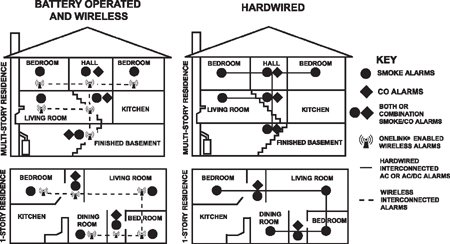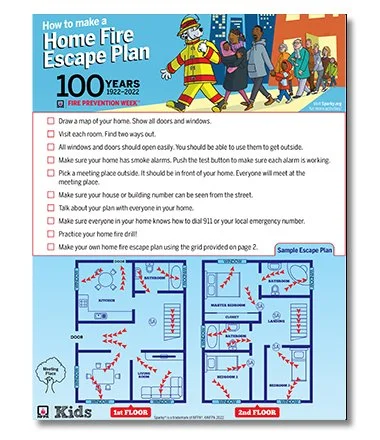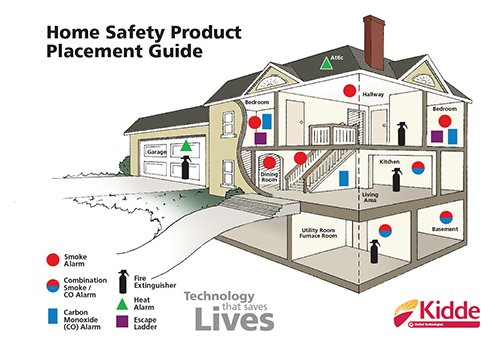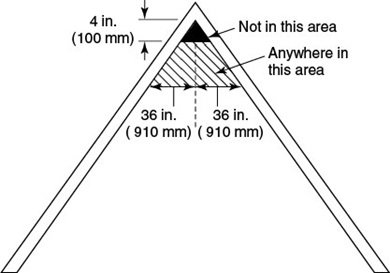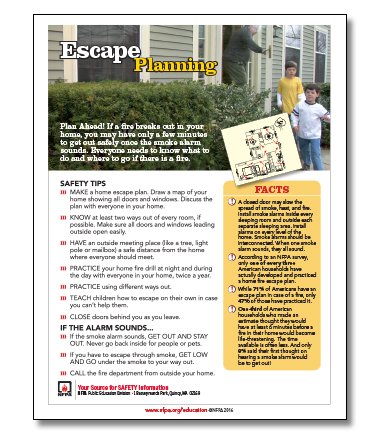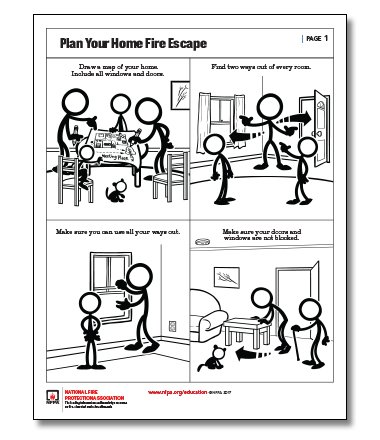SMOKE ALARM SAFETY
Installing smoke alarms
Choose smoke alarms that have the label of a recognized testing laboratory.
Install smoke alarms inside each bedroom, outside each sleeping area and on every level of the home, including the basement.
On levels without bedrooms, install alarms in the living room (or den or family room) or near the stairway to the upper level, or in both locations.
Smoke alarms installed in the basement should be installed on the ceiling at the bottom of the stairs leading to the next level.
Smoke alarms should be installed at least 10 feet (3 meters) from a cooking appliance to minimize false alarms when cooking.
Mount smoke alarms high on walls or ceilings (remember, smoke rises). Wall-mounted alarms should be installed not more than 12 inches away from the ceiling (to the top of the alarm).
If you have ceilings that are pitched, install the alarm within 3 feet of the peak but not within the apex of the peak (four inches down from the peak).
Don't install smoke alarms near windows, doors, or ducts where drafts might interfere with their operation.
Never paint smoke alarms. Paint, stickers, or other decorations could keep the alarms from working.
For the best protection, interconnect all smoke alarms. When one smoke alarm sounds they all sound. Interconnection can be done using hard-wiring or wireless technology.
When interconnected smoke alarms are installed, it is important that all of the alarms are from the same manufacturer. If the alarms are not compatible, they may not sound.
There are two types of smoke alarms – ionization and photoelectric. An ionization smoke alarm is generally more responsive to flaming fires, and a photoelectric smoke alarm is generally more responsive to smoldering fires. For the best protection, both types of alarms or combination ionization-photoelectric alarms, also known as dual sensor smoke alarms, are recommended.
Keep manufacturer’s instructions for reference.
Testing smoke alarms
Smoke alarms should be maintained according to manufacturer’s instructions.
Test smoke alarms at least once a month using the test button.
Make sure everyone in the home understands the sound of the smoke alarm and knows how to respond.
Follow manufacturer’s instructions for cleaning to keep smoke alarms working well. The instructions are included in the package or can be found on the internet.
Smoke alarms with non-replaceable 10-year batteries are designed to remain effective for up to 10 years. If the alarm chirps, warning that the battery is low, replace the entire smoke alarm right away.
Smoke alarms with any other type of battery need a new battery at least once a year. If that alarm chirps, warning the battery is low, replace the battery right away.
When replacing a battery, follow manufacturer’s list of batteries on the back of the alarm or manufacturer’s instructions. Manufacturer’s instructions are specific to the batteries (brand and model) that must be used. The smoke alarm may not work properly if a different kind of battery is used.
HOME FIRE ESCAPE PLANNING
Your ability to get out of your home during a fire depends on advance warning from smoke alarms and advance planning. Fire can spread rapidly through your home, leaving you as little as one or two minutes to escape safely once the smoke alarm sounds.
A closed door may slow the spread of smoke, heat and fire. Install smoke alarms in every sleeping room and outside each separate sleeping area. Install alarms on every level of the home. Pull together everyone in your household and make a plan. Walk through your home and inspect all possible exits and escape routes. Households with children should consider drawing a floor plan of your home, marking two ways out of each room, including windows and doors.
Escape Planning Tips
Pull together everyone in your household and make a plan. Walk through your home and inspect all possible exits and escape routes. Households with children should consider drawing a floor plan of your home, marking two ways out of each room, including windows and doors. Also, mark the location of each smoke alarm.
A closed door may slow the spread of smoke, heat and fire. Install smoke alarms in every sleeping room, outside each sleeping area and on every level of the home. NFPA 72, National Fire Alarm Code® requires interconnected smoke alarms throughout the home. When one sounds, they all sound.
When you walk through your plan, check to make sure the escape routes are clear and doors and windows can be opened easily.
Choose an outside meeting place (i.e. neighbor's house, a light post, mailbox, or stop sign) a safe distance in front of your home where everyone can meet after they've escaped. Make sure to mark the location of the meeting place on your escape plan.
Go outside to see if your street number is clearly visible from the road. If not, paint it on the curb or install house numbers to ensure that responding emergency personnel can find your home.
Have everyone memorize the emergency phone number of the fire department. That way any member of the household can call from a neighbor's home or a cellular phone once safely outside.
If there are infants, older adults, or family members with mobility limitations, make sure that someone is assigned to assist them in the fire drill and in the event of an emergency. Assign a backup person too, in case the designee is not home during the emergency
If windows or doors in your home have security bars, make sure that the bars have emergency release devices inside so that they can be opened immediately in an emergency. Emergency release devices won't compromise your security - but they will increase your chances of safely escaping a home fire.
Tell guests or visitors to your home about your family's fire escape plan. When staying overnight at other people's homes, ask about their escape plan. If they don't have a plan in place, offer to help them make one. This is especially important when children are permitted to attend "sleepovers" at friends' homes.
Be fully prepared for a real fire: when a smoke alarm sounds, get out immediately. Residents of high-rise and apartment buildings may be safer "defending in place."
Once you're out, stay out! Under no circumstances should you ever go back into a burning building. If someone is missing, inform the fire department dispatcher when you call. Firefighters have the skills and equipment to perform rescues.
Put your plan to the test
Practice your home fire escape plan twice a year, making the drill as realistic as possible.
Make arrangements in your plan for anyone in your home who has a disability.
Allow children to master fire escape planning and practice before holding a fire drill at night when they are sleeping. The objective is to practice, not to frighten, so telling children there will be a drill before they go to bed can be as effective as a surprise drill.
It's important to determine during the drill whether children and others can readily waken to the sound of the smoke alarm. If they fail to awaken, make sure that someone is assigned to wake them up as part of the drill and in a real emergency situation.
If your home has two floors, every family member (including children) must be able to escape from the second floor rooms. Escape ladders can be placed in or near windows to provide an additional escape route. Review the manufacturer's instructions carefully so you'll be able to use a safety ladder in an emergency. Practice setting up the ladder from a first floor window to make sure you can do it correctly and quickly. Children should only practice with a grown-up, and only from a first-story window. Store the ladder near the window, in an easily accessible location. You don't want to have to search for it during a fire.
Always choose the escape route that is safest – the one with the least amount of smoke and heat – but be prepared to escape under toxic smoke if necessary. When you do your fire drill, everyone in the family should practice getting low and going under the smoke to your exit.
Closing doors on your way out slows the spread of fire, giving you more time to safely escape.
In some cases, smoke or fire may prevent you from exiting your home or apartment building. To prepare for an emergency like this, practice "sealing yourself in for safety" as part of your home fire escape plan. Close all doors between you and the fire. Use duct tape or towels to seal the door cracks and cover air vents to keep smoke from coming in. If possible, open your windows at the top and bottom so fresh air can get in. Call the fire department to report your exact location. Wave a flashlight or light-colored cloth at the window to let the fire department know where you are located.
Clear your escape routes
Items that block doors and windows in your home could keep you from escaping in the event of a home fire. And that could mean the difference between life and death. So unblock your exits today! Key to your family’s safety is planning and practicing a home fire escape plan twice a year. Start by identifying two escape routes out of each room, if possible, then make sure that each of those escape routes can be used safely by everyone.

